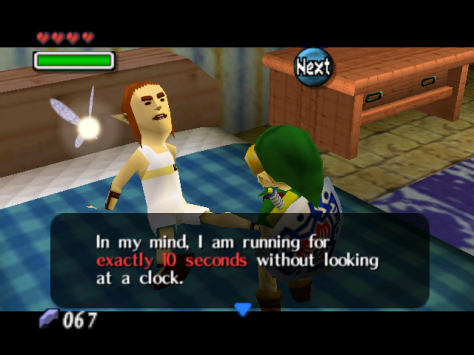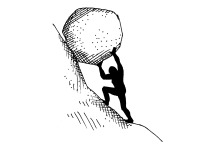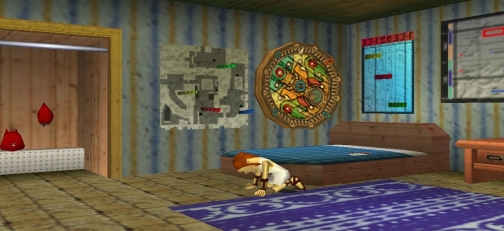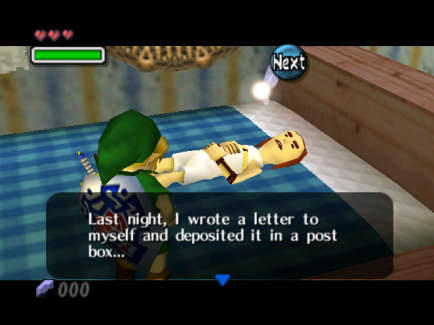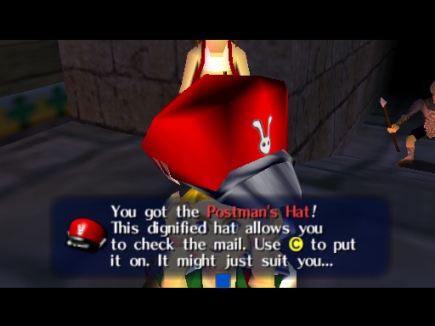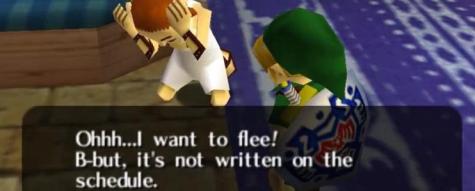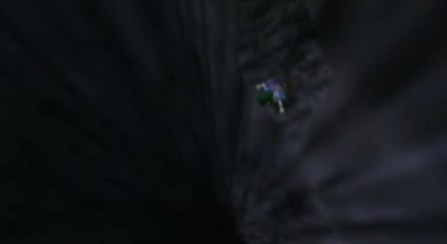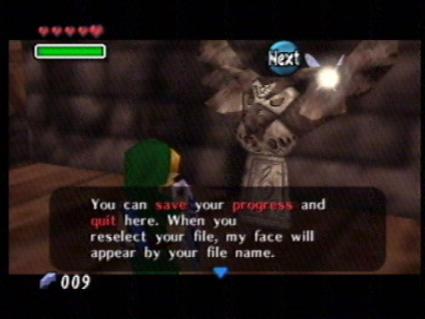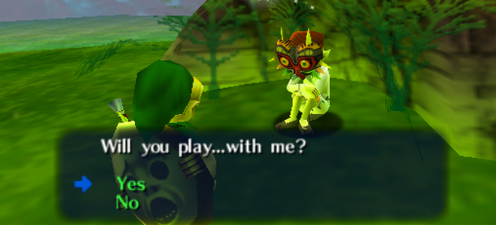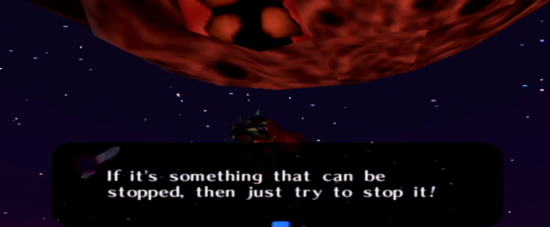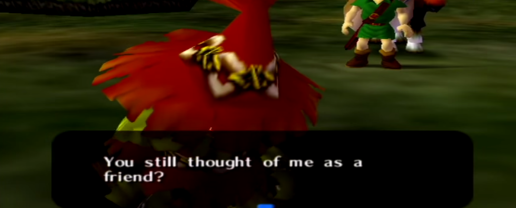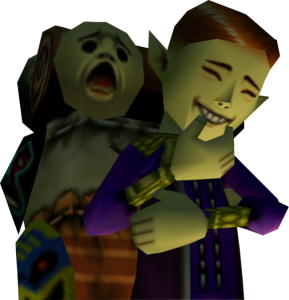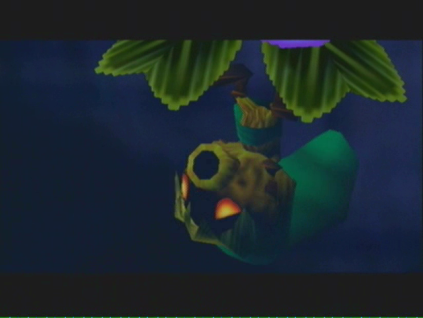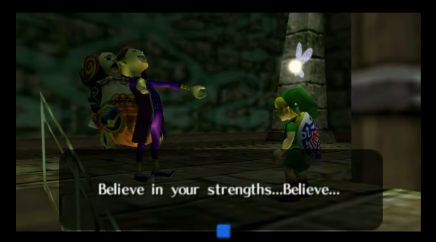My work on “Majora’s Mask” would not encompass the intriguing strangeness of the game without mentioning “Them.” Never given a name, They are entities that descend upon Romani Ranch in Termina every two years, and abduct cows. They are never explained, and Link doesn’t need to confront them to complete the game’s main quest; rather, this is a side quest where only the well being of ranch owner Cremia, her little sister Romani (pictured below with Link), and their cows, is apparently at stake. If Link stops Them, then he is set on the path to being rewarded with a Mask; if he fails, then not only are cows abducted, but Romani is abducted, only to be returned with her memories erased.
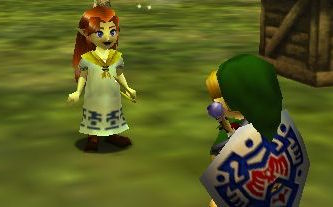
There are plenty of approaches one can take in speculating on this bizarre pocket of Termina’s three-day existence. In this article, I offer what I hope to be a novel and useful commentary on what narratologically makes Them work well. To do so, I will compare the use of aliens in “Majora” to what I see as an informatively bad implementation of aliens in video games: the “Assassin’s Creed” series (I mainly have in mind the Desmond Miles arc, spanning “Assassin’s Creed” through “Assassin’s Creed III”). What I hope to begin to draw out is a mode of understanding what leads the alien to be either useful or detrimental to the architecture of a video game.
It’s worthwhile to preface this commentary with a couple of background points. First, from early on in this enterprise, I’ve made no secret of my feelings toward the trajectory of “Assassin’s Creed” as a series. As a disclaimer, however, I should point out that there are many things I feel the games of the series do well, and I do not mean to offer a comprehensive overview of the series in this handful of posts within my analysis of “Majora.” As such, if the reader feels more comfortable considering my critique of “Assassin’s Creed” as something more along the lines of a generic theoretical foil, then they should by all means do so — it shouldn’t impact the following discourse.
Secondly, I’m being very generous with what I gloss as ‘aliens’. In “Majora,” They are sometimes referred to as “ghosts”; in “Assassin’s Creed,” the entities I have in mind — the “First Civilization” — actually existed on earth prior to humans. Therefore, one might say that neither beings are, strictly speaking, “aliens.” What I mean by ‘aliens’ is a set of characteristics that obtain both in the case of Them and in the First Civilization. To name a few such characteristics, I am thinking of: a distinct sense of ‘otherness’ from the normative inhabitants of the relevant world; abilities that allow them to interact with the world in ways that seemingly transcend human capabilities; and a degree of apparent inexplicability within our natural conception of the relevant world.
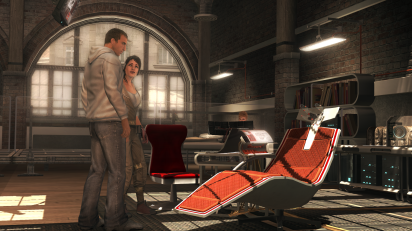
The road to what I see as one of the main narratological problems of “Assassin’s Creed” begins with what I actually see as a major triumph of the series: a victory in meta-gaming. What I refer to as ‘meta-gaming’ is the act of one’s character within a video game engaging in the act of playing a game, such that another game is embedded within the overarching video game (another typical term for a ‘meta-game’, as I am using the term, is ‘mini-game’). I haven’t yet discussed this concept at length, and it will be more appropriate to do so at a later time; suffice it to say, I see most games at failing to justify this mechanic because the player’s character is insignificant in relation to the meta-game. If you come across, say, a casino in “Final Fantasy XIII-2,” you might have the opportunity to play a slot machine; yet there is no meaningful way, when the slot machine fills the screen and the player is left to pull its lever, that the player’s character has a stake in the play of the meta-game. In my mind, a meta-game must earn its keep by maintaining the intermediary of the player’s character as a significant entity; otherwise, it’s probably filler or fluff.
“Assassin’s Creed” passes this test with flying colors. It introduces, as featured above, the novel virtual reality device called “the Animus” (pictured above), which essentially accesses the user’s genetic data and thereby allows the user to assume the role of one of their ancestors. Users can then effectively live out the memories of their ancestors through the virtual reality interface. So, the player enters the world of “Assassin’s Creed” through the character of Desmond Miles, who lives in the present day; Desmond –and, vicariously, the player — then assumes the role of various ancestors by engaging the Animus. The world created by the Animus, then, can be seen as an immense, nontrivial meta-game, and I see that as a triumph in the architecture of interactive, multi-layered narratives.
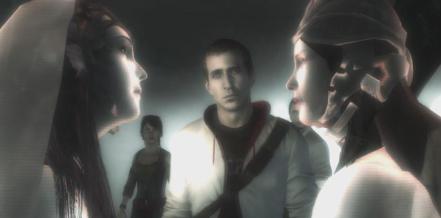
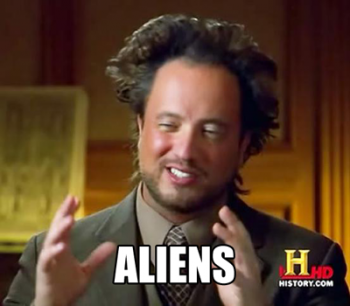
If the architecture of the series ended there, I might well be a strong proponent of it; but that’s only the beginning. The story is locally framed as a struggle between the Templars, who seek to achieve peace through total control of the world, and the Assassins, who seek to achieve peace through individual freedom. All well and good, but also all at the mercy of a First Civilization that created the human race, developed technology to communicate forward in time, and eventually leads your character, Desmond, to kill his companion (Lucy) and himself.
In one way this is a very unfair gloss of what is actually a surprisingly rich mythos, and in another way it’s uncomfortably fair. First, we should take a moment to unpack the mythos a little: in the distant past, the First Civilization essentially developed humans as slaves, and were almost wiped out by them in an ensuing war; later, as a threat of apocalypse by solar flare loomed, the First Civilization developed artifacts and technologies to interact with the underlying patterns of the universe, and to look into the future, by which means they are able to communicate with Desmond and his ancestors. In 2012, another solar flare is threatening the world, and the First Civilization aims to prevent that threat, but internal discord between two of its members — namely, Minerva and Juno (above, pictured arguing in front of Desmond) — lead to Juno trying to manipulate technology to take over the world on her own. Imprisoned for this conspiracy, she conspires to have Desmond release her by using a technological device that kills him, but protects the earth from the solar flare — and also liberates Minerva.
To clarify, I would not take particular issue with a such a story, as stated, as its own entity — complex timelines and world structures, as frequent readers might have guessed, are a few of my favorite things. The crux of the problem, and the reason why I think my previous gloss was “uncomfortably fair,” is that the experience of Assassin’s Creed is rendered out-of-joint by the imposition of an enormous, even transcendental narrative on top of a tidy, interesting story of a cross-time power struggle between Templars and Assassins. The series begins with an emphasis on the Animus, with Desmond encountering his ancestor and slowly uncovering the depth and breadth of the Templar/Assassin conflict; through the vicarious experiences of his ancestors, he is made to understand his lineage, and stake a position in the war of freedom versus control.
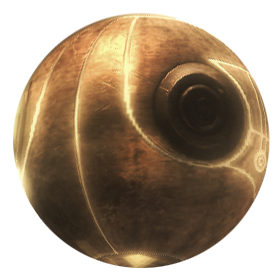
Yet little by little, the alien seeps into the narrative: an Apple of Eden (above) with incomprehensible, seemingly magical powers is uncovered at the end of the first game; Minerva arrives; ultimately, Juno appears and the course of events becomes subsumed by an alien struggle which at times registers at times like a soap opera. Juno’s husband was ultimately killed in an experimental solution to preventing the apocalypse, so she wants to take over the world; “Assassin’s Creed III,” a game whose meta-game chronicles a vast, impressive journey through the revolutionary war by a Native American, concludes with an argument between Minerva and Juno, leading to Desmond killing himself in the hopes of saving humanity. Juno is freed, and ominously says that it is time for her to play her part.
What makes me look upon this is narratologically annoying is baked into the concept of the alien: by its nature, the alien is out of place, mystified, and somewhat out-of-joint. Suddenly, the alien instead subsumes a series whose conceit was the human struggle and exploration of identity across time and lineage. This is messy, and leaves the player questioning what their stake is in the world of the game.
Questioning stake in this way is hugely problematic. When the player is made to question, say, whether the course they are lead to take in a game is morally justified (for example, the case of killing the Garo in “Majora”), the potential to engage with the game on other registers opens up; but when the player questions what relevance at all they have in the course of a game, the incentive to engage with it at all is proportionately diminished. And, to be blunt, if we follow the spirit of my earlier analysis regarding the worlds of games nontrivially depending upon player agency, then we might say that the narrative course I just described makes “Assassin’s Creed” substantially less of a video game series by discounting player agency.
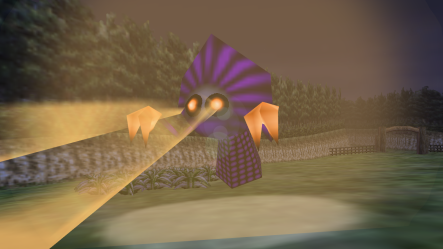
In the same places where I argue “Assassin’s Creed” errs with respect to the alien, I see “Majora’s Mask” succeeding. By no means are They the most interesting or important element of the game, but they make good theoretic sense: in a way that we might suppose necessary for the alien to remain alien rather than becoming normative, They appear only in an optional quest within the game — in point of fact, Cremia actually initially doubts that They exist, and thinks that Romani is playing silly games. This preserves not only Their otherness, but also the authority of Link’s agency: in spite of Their inexplicable materialization in a ball of light, “beaming up” of cows, and brainwashing of Romani, the consequences of Link not defeating Them are contained within a local area of Termina, and is also contained to that particular timeline of Termina. In no way could They threaten the structure of Link’s struggle against the moon’s descent, or the metaphysical tension between the Clock Town Theme and the Song of Time.
Indeed, part of what makes Them so bizarre and memorable is that They are purely a local phenomenon, never speaking, never explained, always a threat to Romani Ranch but never a threat to the universe of Termina. Interestingly, I think this is why They are perceived as “alien” whereas Link and Skull Kid are not. At first glance, it seems as though two beings who entered Termina from a parallel universe (i.e., Hyrule) would be the ultimate aliens — yet in spite of their ontology, our entire understanding of Termina is grounded in these two characters, making them far more central and far less ‘other’ than the rest of Termina. In this way, Link and Skull Kid are actually similar to Minerva and Juno: with preexisting history and conflict, they are thrown into a universe distinct from their own. If we were somehow put in the shoes of a citizen of Termina prior to Link’s arrival (something which I have argued may not be coherently imaginable), then we might be just as bothered with these two strangers as I am with the First Civilization. But because of where the player and their agency is focalized in each narrative, “Majora” ends up being consistently framed by Link and Skull Kid, whereas “Assassin’s Creed” is progressively subsumed by the alien, until the alien is normative and the player lacks grounding.



